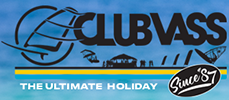JEM HALL
MOVE ON UP – WINDSURFING TECHNIQUE
WE CAN VULCAN
This time of year we could well be blessed with wind or be jetting off for a windy holiday and with this in mind and my desire to keep you moving forward, I would like to entice and coach you to learn to Vulcan as the Vulcan is the perfect introductory move to intermediate freestyle. I learnt this move a long time ago and it kept me sane whilst sailing on flat water, challenged me and readied me (and hopefully you!) to learn other moves that require a high amount of attempts (reps) and the inevitable crashes that can ensue. As ever, I implore you to be comfortable with being uncomfortable and ready for change. So let’s crack on with some top tips to educate, enthuse and inspire you to get the Can in your Vulcan, and I will highlight some common pitfalls also. For now, please say, visualize and repeat: ‘Early head and fast hands.’ Patience grasshopper all will be revealed.
Words Jem Hall // Photo Nicolas Jones
www.jemhall.com
(This feature originally appeared in the July 2015 issue of Windsurf Magazine. To read more features like this first, Print and Digital subscriptions are available. Prices include delivery globally for 10 x issues a year!)
TOYS TOYS TOYS
I attempted to learn this move back in the day on the old school longer thinner boards of the time and actually only fully cracked it when the first freestyle boards came out. These wider platforms, or a big (relatively) freestyle wave / freemove board, really help with the learning of this move as they give you balance and time to slide (plane) backwards which buys you vital seconds to get your hand change sorted. You will also need a smaller fin to help you pop and then slide without catching, 20 – 22cms is good at the start and then size down again when competent.
The older freestyle boards were very user friendly and are also great for this move and enjoying a bit of bump n jump action too. If you are very serious about freestyle the latest incarnations are a little more dedicated these days, offering high speed performance for modern freestyle power moves and popping and sliding like a ninja.
My tip for these later species is to place your straps forward at first, as the modern boards have their straps situated quite far back for the likes of Kiri and Gollito’s aerial antics.
Drills before the Skills
Whoa there cowboy and cowgirl, before you go off popping and sliding into oblivion lets give you some skills to steel yourself for the task ahead. As I said last month, preparation is key and the same applies for this move, be ready, enjoy the journey and be aware that crashing (feedback) is a part of the learning process.
Preparation drills to Can the Vulcan
• Popping – ensure you are very happy getting over the board and popping it in either direction, both across the wind and slightly downwind. Focus on opening the sail pre pop and the push and pull of the legs during the pop. Crouch down, pull boom down then spring up, helps initiate pop. No hop, skip and jumping!
• Tail grab jumps (hooked in) – release the backhand once you are in the air and touch/grab the tail. This gets your popping up a level and ensures that you really bend your back leg and that your hands get faster and freer, ready for the VulCan.
• Boom to boom tacks – Whilst you may use the mast for tacking, the BtB tack prepares your hands further to be fast and familiar with the hand change. Top Tip: learn Vulcans BtB so you have fast hands, and have to land with your weight forward as this will make your hands fast and open up learning to spock (Vulcan with a heli tack to make it a full 360)
• Sailing switch – Just as in gybes, where you can practice clew first sailing to improve your exit skills, sailing switch helps practice the finish to the VulCan and completing the move. To practice so, do a gybe and remain with both feet in the straps throughout the sail change and only get out of the straps after sailing on the new direction.
The moves that matter
Let’s get down to business and give you a simple guide to the key actions to be performed.
Key Moves
• Slide front hand up to mast ready for fast hands
• Unhook and crouch down over the board, ready to pop and scissor the board to sail slightly off the wind.
• Pop and almost simultaneously look behind you (check the pic of my shiney head) whilst releasing the backhand in order to initiate the board rotation.
• Draw rig tight across your chest as back leg comes up to get the nose down ready for the slide. Fast hands draws the rig forward so the new side of the boom will become available and in view.
• Keep weight forward, land and lean on your toeside rail and the new side of the boom should be there and accessible if you have fast hands and an early head change of course.
• Switch hands. The old backhand goes over the front hand to become the new front hand and it is a boom-to-boom transition. Weight still forward, un-weighting the tail.
• Slide backwards, keeping weight centred and forward to assist the slide.
• Sheet in whilst switch foot as you slow down. Counterbalance the sails power.
• Get stable whilst in switch stance and sail off the wind ready to switch your feet.
• Change your feet and exit. Whoop!, well just quietly.
Well done, keep at it and be ready to get a lot of feedback (crashes) to nail this move, you can, shall and will VulCan and then you have got the gateway to freestyle nailed and the door is open to progress further.



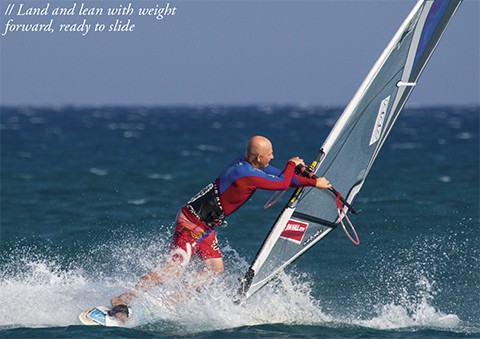

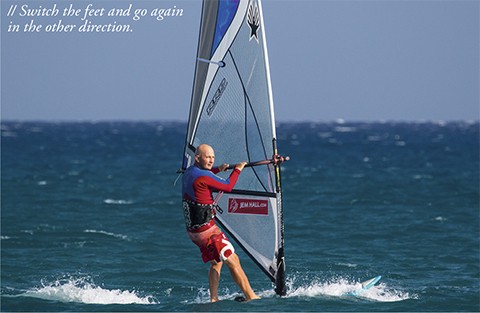
Main tips and useful mantras
Let’s examine the key tips and useful mantras to repeat and focus on. These can serve as targets and also as self-coaching points.
• Early head; for me this is crucial! As I pop I turn my head to look back which turns my shoulders and hips in order to get the board rotating.
• Fast hands; again this is equally important as the previous tip. Moving your hands tight across your chest and fast draws the mast forward to get you landing with your weight forward to open up sliding opportunities.
• Land and lean; as you land, lean forward and over your toeside (this avoids the rail and tail catching). If your hands are fast, the rig will draw you this way and again, you will love the slide!
• Kiss the nose; goes with the previous tip to keep you landing with your
weight forward.
• Stay centred; this move not only requires you to land leaning forward but also centred over the board so you can slide and then take the power up on the new side of the sail.
• Power up and get back and outboard; once the hands are on the boom and just before you finish sliding you will need to sheet the sail in ready for completing the move. Aim to counterbalance the amount of wind in the sail. i.e. lean out and forward if it is light and lean outboards even more to control more wind. That sailing switch drill comes in very handy here!
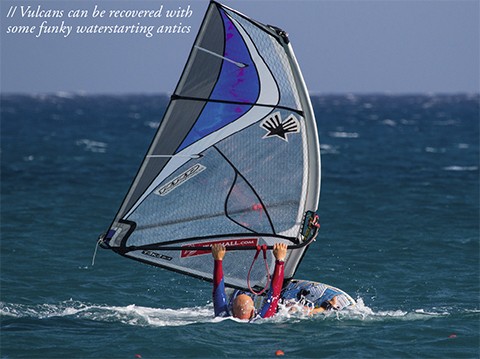
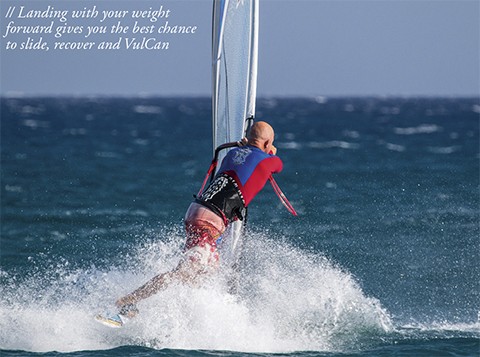
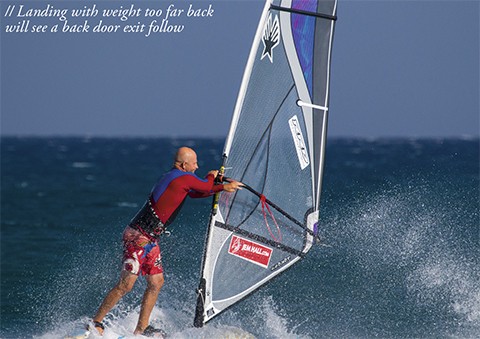
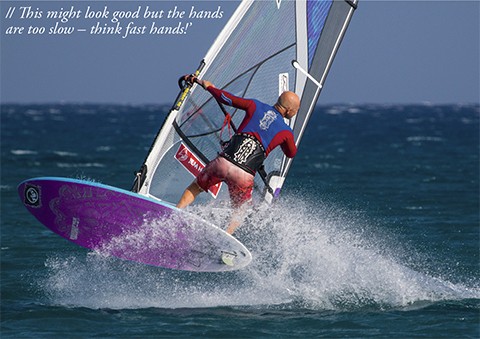
REMEDIES
There are some common crashes in the Vulcan so lets examine a cure for these:
- SYMPTOM; not getting board round far enough and then crashing out the side door fast.
CURE; ensure the sail is open and the board is ready to pop and you are over the board and take off across or down wind and pop aggressively. - SYMPTOM; Not getting the board out of the water effectively.
CURE; really work on the pop with your legs to release the board and your front arm to pull up and on no account ever bounce (2 pops or more in a row) into any aerial moves. - SYMPTOM; consistently landing and sinking tail (going out the back door).
CURE; get hands faster and lean forward more on landing or land more over toeside with body weight centred over board. - SYMPTOM; catapulted whilst switch foot.
CURE; let the board slide, decelerate and then sheet in with an effective counter balanced position. - SYMPTON; falling at the final hurdle of the foot switch.
CURE; focus on effective power control in switch mode before you think the job is done. After this, pull down on the boom to lighten feet and then pull out the back foot and front foot almost simultaneously.
Kit
Generous straps to allow you to land on your toeside
Small fin for the slide and easy pop. Maximum 22cms!
Long lines enable you to sail fast over bumpy water and over your kit
Conditions
Flat
Small waves with space between
Swell with flat spots
Go to the right spot to get the right conditions
Safer and easier in moderate winds to start with
RRD boards, wetsuits, softwear, Ezzy sails and Pro Sport Sunblock sponsor Jem Hall. Get him live and direct on one of his highly acclaimed coaching holidays. You can also follow him on twitter / Facebook and Instagram.
More information at

